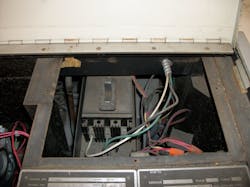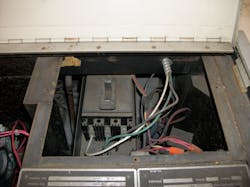What’s Wrong Here? Hint: Green is Not Always Good
How well do you know the Code? Think you can spot violations the original installer either ignored or couldn't identify? Here's your chance to moonlight as an electrical inspector and second-guess someone else's work from the safety of your living room or office. It's your turn to identify the violation.
Hint: Green is not always good.
Find the Answer
This photo was sent in by Chris Surowiec, a project manager – estimator for Lee's Electrical Contracting, Inc. in Baltimore.
The lack of a connector on the MC cable is a violation of 300.10. This section of the Code requires metal cables to be mechanically secured and connected to the enclosure in a manner that will provide electrical continuity. More importantly, connecting the green wire to the circuit breaker terminal creates a violation of 250.119, since wires with green insulation cannot be used as an ungrounded conductor on this 480V circuit.
Since there is no connector on the MC cable and the green wire is not being used as an equipment ground wire, this MC cable provides no effective ground fault current path in accordance with 250.118(10). This increases the shock hazard for an already dangerous situation, because the equipment supplied by this MC cable is not grounded and bonded in accordance with many other requirements of Art. 250, including, but not limited to, Secs. 250.4(A)(5) and 250.4(B)(4).
The use of the white wire as an ungrounded conductor for this MC cable is permitted by 200.7(C)(1), but only if it is reidentified with marking tape, paint, or other approved means to indicate such use.
About the Author

Russ LeBlanc
Owner
Russ started in the electrical trade as an apprentice in 1985. He worked his way up to become a Journeyman Electrician and then eventually became a Master Electrician and Licensed Construction Supervisor. In 1999 Russ become an Electrical Instructor for The Peterson School of Engineering in Massachusetts where he developed his passion for teaching, and quickly became Department Head of Electrical Instruction. Russ has taught thousands of apprentices, electricians, engineers, inspectors, and other electrical professionals during his career as an instructor. He continues to provide electrical professionals with Electrical Code seminars, Arc-Flash Awareness training seminars and educational material through his LeBlanc Consulting Services in North Reading, MA whose specialty is educating electricians. He has been an active member of the NFPA Electrical Section and has authored hundreds of National Electrical Code proposals and comments which have become Code rules to improve the safety for the electrical industry. Russ is also an IAEI certified Electrical Inspector.
Please visit www.russleblanc.net for more information.

